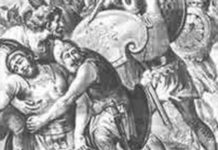Although many kinds of swords were used by the military, gladiators and civilians of the Roman Empire the best known are the Parazonium, the Sica, the Gladius and the Spatha.
None of these weapons was of Roman origin.
Parazonium
Not really a weapon of war the Parazonium was most likely a sign or rank. The Romans kept the leaf shaped blade – which was between 15 and 19 inches long – and changed the hilt, grip and pommel of the Greek designed short sword. It is documented that Roman legates as well as other officers carried Parazoniums into battle. The weapon was not used for fighting but as s symbol of their authority and for rallying the legionnaires. Virtus, the Roman deity of virtue, Mars or even the emperor carried Parazoniums in many statues and paintings.
Sica
The origin of the vicious, curved, short sword known as the Sica can be traced to the Indo-European tribes of Central and Southeastern Europe such as the Thracian and Illyrians. To the Romans, it was a not military weapon per se and it was the kind of blade only criminals would use. Since the shape of the Sica was particularly suitable to get around shields, and it was wielded by the tribe of the same name, Thracian or Thraex Gladiators used it. When used with the point down, it was an excellent cutting weapon that could severed an arm, or a throat. But a veteran gladiator would master a stroke with the curved point up. The Sica would go into an opponent’s jaw and with a jerking movement it would slash his face in half.
Gladius
The best known sword of Roman times was the Gladius, or better, the Gladius Hispaniensis (Spanish Sword). There is some argument about the origin of the Gladius, but everything appears to point out to the Romans adopting a weapon used by Iberian mercenaries at the service of Carthage during the Punic Wars. With a total length of no more than three feet and a blade length of aobut2.25 feet, the Gladius Hispaniensis was almost tailor made for the kind of close quarter combat the Legions engaged in after throwing their lances. Made of steel, with handles of various metals or wood, there were three main types or Gladius. They had minor differences in weight, shape and length. The types were named for the areas where they were first found by archeologists: Mainz, Germany; Fulham, Britain; ad Pompeii, Italy; the last one being the most common. The Gladius was not only standard military with the military, but it was the main weapon of various types of gladiators. It remained popular until the first century AD when it began to be replaced by the Spatha.
Spatha
A full six inches longer than the Gladius, the Spatha probably entered the Roman world at the hand of Celtic and Germanic auxiliary troops. It would replace the shortest sword in the next two centuries as the everyday weapon of the cavalry and heavy infantry. The substitution of weapons may have been cause, at least in part, by the larger numbers of Barbarians that were serving in the Roman legions. They simply rather employ the Spatha for they were used to it. There are theories that the Spatha originated in Iberia or Sarmatia, but it in reality nobody knows where it comes from. The Roman infantry employed a sharp pointed Spatha to stab the enemy, while the cavalry used a round pointed one to protect the rider’s feet. The cavalry blade was probably heavier and had sharp edges for cutting. Descendants of the Spatha, in the form of the Viking and Knight Swords, as well as sabers and others, continued to be use in warfare well into the early 20th Century.








